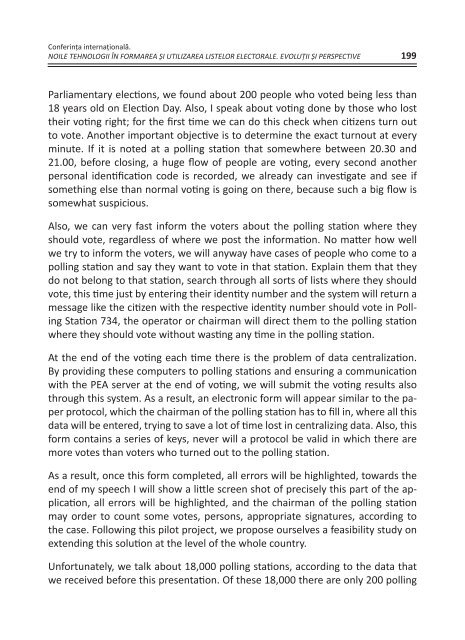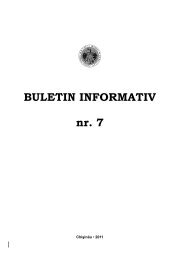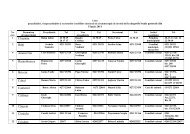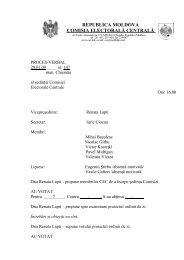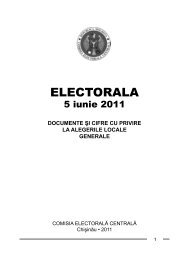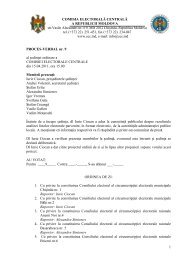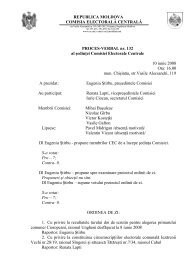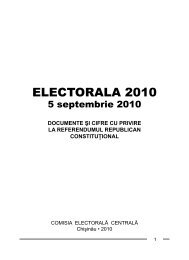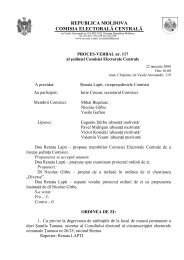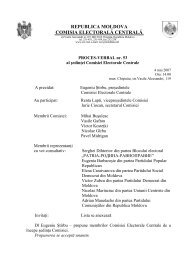noile tehnologii în formarea Åi utilizarea listelor electorale ... - Cec.md
noile tehnologii în formarea Åi utilizarea listelor electorale ... - Cec.md
noile tehnologii în formarea Åi utilizarea listelor electorale ... - Cec.md
- No tags were found...
Create successful ePaper yourself
Turn your PDF publications into a flip-book with our unique Google optimized e-Paper software.
Conferinţa internaţională.<br />
NOILE TEHNOLOGII ÎN FORMAREA ŞI UTILIZAREA LISTELOR ELECTORALE. EVOLUŢII ŞI PERSPECTIVE 199<br />
Parliamentary elections, we found about 200 people who voted being less than<br />
18 years old on Election Day. Also, I speak about voting done by those who lost<br />
their voting right; for the first time we can do this check when citizens turn out<br />
to vote. Another important objective is to determine the exact turnout at every<br />
minute. If it is noted at a polling station that somewhere between 20.30 and<br />
21.00, before closing, a huge flow of people are voting, every second another<br />
personal identification code is recorded, we already can investigate and see if<br />
something else than normal voting is going on there, because such a big flow is<br />
somewhat suspicious.<br />
Also, we can very fast inform the voters about the polling station where they<br />
should vote, regardless of where we post the information. No matter how well<br />
we try to inform the voters, we will anyway have cases of people who come to a<br />
polling station and say they want to vote in that station. Explain them that they<br />
do not belong to that station, search through all sorts of lists where they should<br />
vote, this time just by entering their identity number and the system will return a<br />
message like the citizen with the respective identity number should vote in Polling<br />
Station 734, the operator or chairman will direct them to the polling station<br />
where they should vote without wasting any time in the polling station.<br />
At the end of the voting each time there is the problem of data centralization.<br />
By providing these computers to polling stations and ensuring a communication<br />
with the PEA server at the end of voting, we will submit the voting results also<br />
through this system. As a result, an electronic form will appear similar to the paper<br />
protocol, which the chairman of the polling station has to fill in, where all this<br />
data will be entered, trying to save a lot of time lost in centralizing data. Also, this<br />
form contains a series of keys, never will a protocol be valid in which there are<br />
more votes than voters who turned out to the polling station.<br />
As a result, once this form completed, all errors will be highlighted, towards the<br />
end of my speech I will show a little screen shot of precisely this part of the application,<br />
all errors will be highlighted, and the chairman of the polling station<br />
may order to count some votes, persons, appropriate signatures, according to<br />
the case. Following this pilot project, we propose ourselves a feasibility study on<br />
extending this solution at the level of the whole country.<br />
Unfortunately, we talk about 18,000 polling stations, according to the data that<br />
we received before this presentation. Of these 18,000 there are only 200 polling


